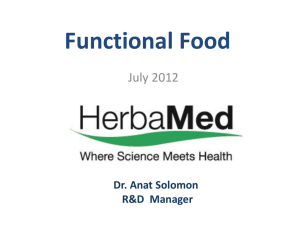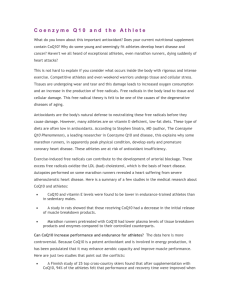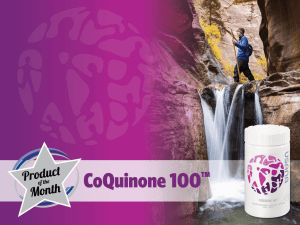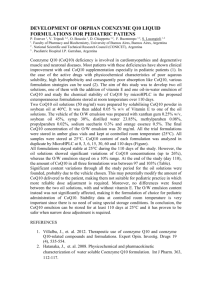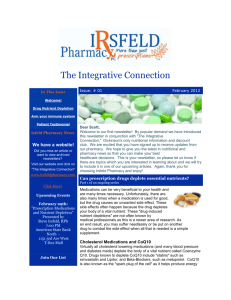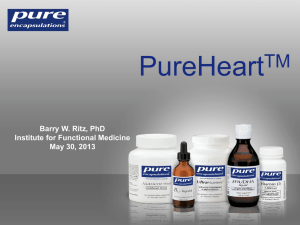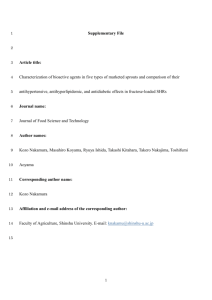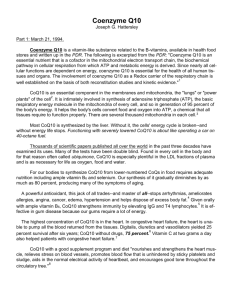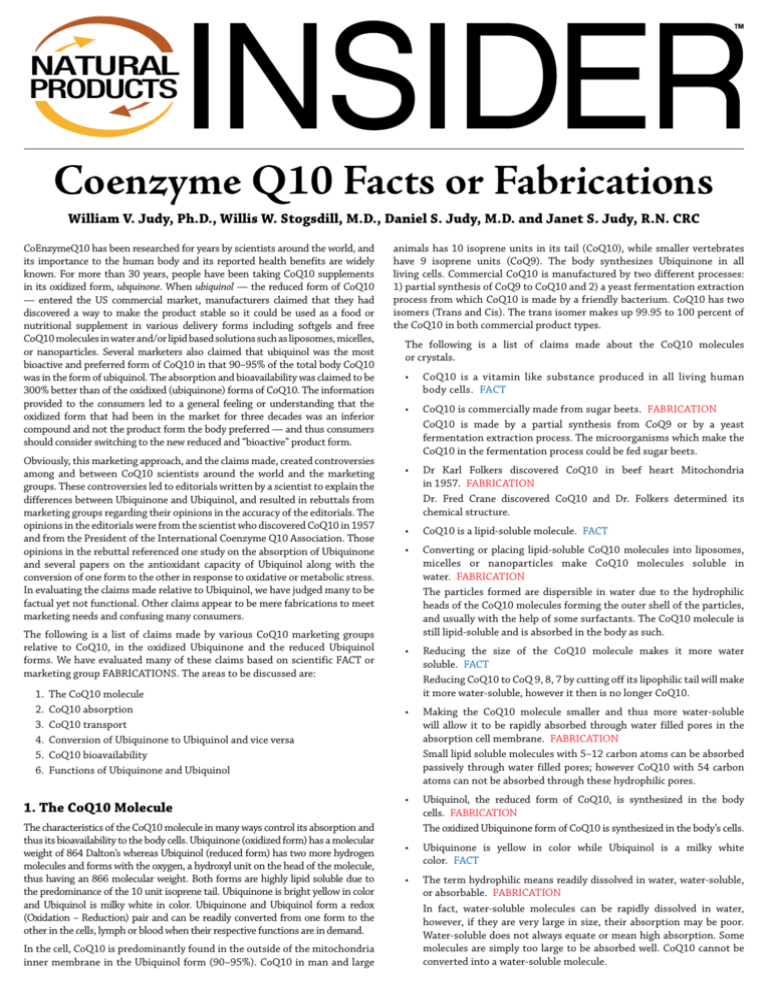
NATURAL
PRODUCTS
Coenzyme Q10 Facts or Fabrications
William V. Judy, Ph.D., Willis W. Stogsdill, M.D., Daniel S. Judy, M.D. and Janet S. Judy, R.N. CRC
CoEnzymeQ10 has been researched for years by scientists around the world, and
its importance to the human body and its reported health benefits are widely
known. For more than 30 years, people have been taking CoQ10 supplements
in its oxidized form, ubquinone. When ubiquinol — the reduced form of CoQ10
— entered the US commercial market, manufacturers claimed that they had
discovered a way to make the product stable so it could be used as a food or
nutritional supplement in various delivery forms including softgels and free
CoQ10 molecules in water and/or lipid based solutions such as liposomes, micelles,
or nanoparticles. Several marketers also claimed that ubiquinol was the most
bioactive and preferred form of CoQ10 in that 90–95% of the total body CoQ10
was in the form of ubiquinol. The absorption and bioavailability was claimed to be
300% better than of the oxidixed (ubiquinone) forms of CoQ10. The information
provided to the consumers led to a general feeling or understanding that the
oxidized form that had been in the market for three decades was an inferior
compound and not the product form the body preferred — and thus consumers
should consider switching to the new reduced and “bioactive” product form.
Obviously, this marketing approach, and the claims made, created controversies
among and between CoQ10 scientists around the world and the marketing
groups. These controversies led to editorials written by a scientist to explain the
differences between Ubiquinone and Ubiquinol, and resulted in rebuttals from
marketing groups regarding their opinions in the accuracy of the editorials. The
opinions in the editorials were from the scientist who discovered CoQ10 in 1957
and from the President of the International Coenzyme Q10 Association. Those
opinions in the rebuttal referenced one study on the absorption of Ubiquinone
and several papers on the antioxidant capacity of Ubiquinol along with the
conversion of one form to the other in response to oxidative or metabolic stress.
In evaluating the claims made relative to Ubiquinol, we have judged many to be
factual yet not functional. Other claims appear to be mere fabrications to meet
marketing needs and confusing many consumers.
The following is a list of claims made by various CoQ10 marketing groups
relative to CoQ10, in the oxidized Ubiquinone and the reduced Ubiquinol
forms. We have evaluated many of these claims based on scientific FACT or
marketing group FABRICATIONS. The areas to be discussed are:
1.
2.
3.
4.
5.
6.
The CoQ10 molecule
CoQ10 absorption
CoQ10 transport
Conversion of Ubiquinone to Ubiquinol and vice versa
CoQ10 bioavailability
Functions of Ubiquinone and Ubiquinol
1. The CoQ10 Molecule
The characteristics of the CoQ10 molecule in many ways control its absorption and
thus its bioavailability to the body cells. Ubiquinone (oxidized form) has a molecular
weight of 864 Dalton’s whereas Ubiquinol (reduced form) has two more hydrogen
molecules and forms with the oxygen, a hydroxyl unit on the head of the molecule,
thus having an 866 molecular weight. Both forms are highly lipid soluble due to
the predominance of the 10 unit isoprene tail. Ubiquinone is bright yellow in color
and Ubiquinol is milky white in color. Ubiquinone and Ubiquinol form a redox
(Oxidation – Reduction) pair and can be readily converted from one form to the
other in the cells, lymph or blood when their respective functions are in demand.
In the cell, CoQ10 is predominantly found in the outside of the mitochondria
inner membrane in the Ubiquinol form (90–95%). CoQ10 in man and large
animals has 10 isoprene units in its tail (CoQ10), while smaller vertebrates
have 9 isoprene units (CoQ9). The body synthesizes Ubiquinone in all
living cells. Commercial CoQ10 is manufactured by two different processes:
1) partial synthesis of CoQ9 to CoQ10 and 2) a yeast fermentation extraction
process from which CoQ10 is made by a friendly bacterium. CoQ10 has two
isomers (Trans and Cis). The trans isomer makes up 99.95 to 100 percent of
the CoQ10 in both commercial product types.
The following is a list of claims made about the CoQ10 molecules
or crystals.
•
CoQ10 is a vitamin like substance produced in all living human
body cells. FACT
•
CoQ10 is commercially made from sugar beets. FABRICATION
CoQ10 is made by a partial synthesis from CoQ9 or by a yeast
fermentation extraction process. The microorganisms which make the
CoQ10 in the fermentation process could be fed sugar beets.
•
Dr Karl Folkers discovered CoQ10 in beef heart Mitochondria
in 1957. FABRICATION
Dr. Fred Crane discovered CoQ10 and Dr. Folkers determined its
chemical structure.
•
CoQ10 is a lipid-soluble molecule. FACT
•
Converting or placing lipid-soluble CoQ10 molecules into liposomes,
micelles or nanoparticles make CoQ10 molecules soluble in
water. FABRICATION
The particles formed are dispersible in water due to the hydrophilic
heads of the CoQ10 molecules forming the outer shell of the particles,
and usually with the help of some surfactants. The CoQ10 molecule is
still lipid-soluble and is absorbed in the body as such.
•
Reducing the size of the CoQ10 molecule makes it more water
soluble. FACT
Reducing CoQ10 to CoQ 9, 8, 7 by cutting off its lipophilic tail will make
it more water-soluble, however it then is no longer CoQ10.
•
Making the CoQ10 molecule smaller and thus more water-soluble
will allow it to be rapidly absorbed through water filled pores in the
absorption cell membrane. FABRICATION
Small lipid soluble molecules with 5–12 carbon atoms can be absorbed
passively through water filled pores; however CoQ10 with 54 carbon
atoms can not be absorbed through these hydrophilic pores.
•
Ubiquinol, the reduced form of CoQ10, is synthesized in the body
cells. FABRICATION
The oxidized Ubiquinone form of CoQ10 is synthesized in the body’s cells.
•
Ubiquinone is yellow in color while Ubiquinol is a milky white
color. FACT
•
The term hydrophilic means readily dissolved in water, water-soluble,
or absorbable. FABRICATION
In fact, water-soluble molecules can be rapidly dissolved in water,
however, if they are very large in size, their absorption may be poor.
Water-soluble does not always equate or mean high absorption. Some
molecules are simply too large to be absorbed well. CoQ10 cannot be
converted into a water-soluble molecule.
•
All CoQ10 product types must be placed in colored capsules or dark
containers because CoQ10 is sensitive to light. FABRICATION
Independent laboratory testing has clearly shown that crystal free
CoQ10 in clear gelatin softgel capsules or crystalline CoQ10 have less
than 1% by weight loss and no significant sensitivity to light. The
primary reason for colored softgel capsules is to prevent the consumer
from seeing crystals being formed inside the product.
•
Reduced CoQ10, an antioxidant, remains in the reduced form when
ingested and absorbed. FABRICATION
Reduced CoQ10 is highly unstable in the contents of the stomach and
is converted to oxidized CoQ10 before absorption.
•
The rapid dissolution of a liposome, micelle or nanoparticle
CoQ10 products in water is a good indicator of high CoQ10
absorption. FABRICATION
The rapid dissolution of these CoQ10 products types tells that these polar
particles (water-soluble microspheres) will disperse rapidly in water. This
does not mean that they are better absorbed. Only the CoQ10 molecules
are absorbed, not the liposomes, micelles or nanoparticles.
2. CoQ10 Absorption
CoQ10, being a rather large molecule, is absorbed through the absorption cells
in the small intestines by a “simple passive facilitated diffusion” process. Passive
means that the process does not require energy. Facilitated means that the
process requires a lipid molecule to act as a carrier for the CoQ10 molecules.
Passive diffusion is down-hill transport and requires a greater CoQ10
concentration in the water phase adjacent to the side of the absorption cell
membrane compared to that inside the cell membrane. To a point, the greater
this gradient is, the faster and greater the absorption.
CoQ10 crystals cannot be absorbed. Thus, crystalline compounds must be
dissolved to single molecules before absorption. Intestinal absorption occurs
on a molecular level; meaning only single molecules can be absorbed. CoQ10 in
its crystallized form has poor dissolution within the chyme of the intestines,
because its melting point is 10 degrees centigrade above body temperature.
Without the addition of a lipid carrier molecule to facillate the absorption of
CoQ10, even single molecules are poorly absorbed. This is evidenced by the
poor absorption of CoQ10 plain powder: less than 1%.
The following is a list of claims about CoQ10 absorption:
•
•
•
•
•
For crystals of CoQ10 to be absorbed, they have to be dissolved to
single molecules. FACT
The body’s intestinal absorption cells can not absorb crystals of any type.
CoQ10 is absorbed through an active transport mechanism like that
of sugar. FABRICATION
CoQ10 being a large lipid-soluble molecule, is absorbed by a process
called “simple passive facilitated diffusion” through the phospholipid cell
membranes, not the active transport process.
Combining CoQ10 with a sugar will allow the CoQ10 to be absorbed
with sugar directly into the blood. FABRICATION
Membrane proteins are involved in the absorption of sugar and sodium
via an active transport mechanism. If CoQ10 was absorbed while being
bound to sugar, its Cmax (maximum concentration in blood) would peak
with sugar in about two hours instead of 5–8 hours as for most lipids.
CoQ10 is absorbed across the intestinal cells directly into the venous
blood. FABRICATION
CoQ10 is absorbed across the intestinal cell membranes into the lymph
vessels in the intestinal microvillus, not into the bloodstream.
The poor dissolution of powder based CoQ10 tablets and lipid filled softgels
in simulated gastric juice is a good indicator of poor absorption. FACT
However, since CoQ10 is not soluble in water but is soluble in a lipid,
shouldn’t the solubility test for lipid soluble molecules be done in a
lipid solution?
•
Ubiquinol has far greater water solubility and much better absorption
into the blood stream than does Ubiquinone. FABRICATION
The addition of two hydrogen ions on the polar head of the Ubuquinol
molecule will not make the molecule highly water-soluble or absorbed
as a water-soluble molecule.
•
Ubiquinol is more water-soluble than Ubiquinone. FACT
When two hydrogen’s atoms are added to the polar (water-soluble) head
of the CoQ10 molecule, the increased mass will make Ubiquinol slightly
more water-soluble than Ubiquinone. However, due to the larger total
mass of the nonpolar tail of the molecule, it is still more lipid-soluble
than water-soluble.
•
Liposomes, micelles and nanoparticle CoQ10 products are absorbed,
transported in lymph, blood and to the target body cells as liposomes,
micelles or nanoparticles. FABRICATION
The microspheres can not be absorbed. They are simply transport
vehicles for ingested CoQ10, to be delivered to the intestinal
absorption cells.
3. CoQ10 Transport
Absorbed nutrients are transported from the intestines by two routes.
Small water-soluble and some small lipid-soluble nutrients, after absorption, enter
the capillary blood in the intestinal microvillus and are transported by the blood to
the liver. From the liver these small molecules are transported through the hepatic
vein to the inferior vena cava, then to the heart and then into systemic circulation.
Large lipid-soluble nutrients such as CoQ10, after absorption, diffuse into the
lymph capillary in the intestinal microvillus, and are transported in the lymph
through the abdominal and thoracic lymph duct to the subclavian vein and
then into the systemic circulation. In the lymph and blood, CoQ10 molecules
are predominately in the reduced form and are bound to the low density
lipoproteins (LDL). The delayed peak concentration of CoQ10 in the blood is
due to the very slow lymph flow compared to that of blood. The portal venous
blood is a delivery system to the liver, but the lymph is not.
The following is a list of claims about CoQ10 transport:
•
After CoQ10 absorption, it is transported by the lymph to the liver
where it is reduced and bound to phospholipids. FABRICATION
The lymph is not a delivery system to the liver.
•
CoQ10 is transported from the absorption cells to the venous blood by
the lymphatic system. FACT
The lymph is the delivery system for absorbed CoQ10 molecules to the
systemic blood. Large animal studies show that CoQ10 peaks in the
abdominal lymph duct in 2–3 hours after ingestion where as it peaks
in venous blood in 6–8 hours. The reason for the delayed appearance in
the venous blood is due to slow lymph flow.
•
In the absorption cell, the lymph or the blood oxidized CoQ10 is
converted to the reduced form of CoQ10. FACT
Circulating CoQ10 in the blood is 90–95% in the reduced (Ubiquinol) form.
•
CoQ10 is rapidly absorbed in the small intestines and is slowly
transported by the lymph to the venous blood. FACT
Total lymph flow is about 100 ml/minute whereas blood flow is
5,000 ml/minute.
4. Conversion of Ubiquinol to Ubiquinone and Vice-Versa
Ubiquinone and Ubiquinol, being redox pairs, are easily converted from one
form to the other in the body. For example, when exogenous Ubiquinone is
absorbed in the intestines it is converted to Ubiquinol in the absorption cells,
the lymph, or the blood. Since CoQ10 is not used to produce energy in the
lymph system or blood, it is understandable why this conversion takes place
to fulfill the need for antioxidant protection in the circulation. On the other
hand, in the inner membrane of the mitochondria where energy is made, the
oxidized form of CoQ10 (Ubiquinone) is in great demand. Here the reduced
Ubiquinol form is rapidly converted to the oxidized Ubiquinone form. In
the mitochondria this conversion creates a Q-Cycle. It was once felt by the
late Sir Peter Mitchell (Nobel prize, 1978) that the Q-Cycle would maintain
the proportion of Ubiquione and Ubiquinol required for energy synthesis
available forever. Little did he know at the time of his discovery that with
age and disease the body’s ability to produce Ubiquinone and to convert it to
Ubiquinol would diminish and true CoQ10 deficiencies would be prevalent in
an aging society.
The following is a list of claims about CoQ10 conversion:
•
CQ10 can be converted from the reduced to oxidized form and vise
versa in the body as needed. FACT
This is a unique characteristic of redox pairs.
•
CoQ10 in the foods we eat is in the reduced form. FACT & FABRICATION
The CoQ10 in fresh uncooked animal protein in is the reduced form.
However, when cooked, it is converted to the oxidized form. Even
when ingested uncooked (such as sushi or steak tartar), CoQ10 will be
converted in the stomach to the oxidized form.
•
CoQ10’s ability to cycle back and forth between Ubiquinone and
Ubiquinol accounts for many of its unique properties. FACT
5. CoQ10 Bioavailability
After absorption, CoQ10 accumulates in the blood and becomes bioavailable to
all body cells. Bioavailability reflects absorption but it is not the actual absorption
and should not be used as an accurate measure of such. It does, however, give a
good estimate of the amount of CoQ10 available as an antioxidant in the blood
and that available to the body cells. CoQ10 is accumulated and is stored in the
cell membranes and in the membranes of the organelles in the cell.
It has been known for two decades that the bioavailability of the pure
crystalline CoQ10 is less than that of liposome, micelle, and dissolved CoQ10
products. The current commercial and scientific issue is the bioavailability of
the Ubiquinol form compared to that of the Ubiquinone form of CoQ10.
The following is a list of claims about CoQ10 bioavailability:
•
•
Ubiquinol has a much higher bioavailability then the Ubiquinone used
in other commercial CoQ10 supplements. FABRICATION
In fact, the data on ubiquinol state that its bioavailability is 300 percent
more than that of the oxidized dry powder products. Most dissolved,
liposome, micelle and nanoparticle CoQ10 products claim to have a 260
to 350 percent greater bioavailability than oxidized dry powder CoQ10.
The two hydroxyl groups on the Ubiquinol compound results in its
stronger bonding with water and helps explain why it is so much more
bioavailable than Ubiquinone. FACT
This bonding does make Ubiquinol slightly more water soluble than
Ubiquinone. However, the molecule is still lipophilic and is absorbed as a lipid.
6. Functions of Ubiquinone and Ubiquinol
Currently CoQ10 has two main functions in the body: it is used for energy
production and functions as an antioxidant in the body.
Ubiquinone is a cofactor in the inner membrane of the mitochondria for the
synthesis of energy (ATP). Since the body does not store energy (ATP), it must
be rapidly produced through an oxidative phosphorlation process. CoQ10 is
positioned between NADH and Cyto-Chrome C in the inner membrane and
acts as cofactor stimulation to all three mediators to give up electrons to run
the electron transport through complexes I-IV in this system. This function
is specific to Ubiquinone in that no other molecule can replace Ubiquinone
in this process. However, Ubiquinone and Ubiquinol as a redox pair form the
Q Cycle in which they act to conserve each other in this process.
Ubiquinol is an antioxidant throughout the body. This is especially true in the
cell membranes and those of the cell organelles. In these membranes CoQ10
may well be the primary lipophilic molecule essential for the prevention of lipid
peroxidation resulting in cell damage and eventually cell death. Outside the cell
and organelle membrane and in the presence of other lipophilic and hydrophilic
antioxidants, Ubiquinol may recycle other antioxidants such as vitamin E and C.
The following is a list of claims about the functions of CoQ10
•
Ubiquinol protects the body against toxic oxidative reactions. FACT
Yes, but equally beneficial it also recycles Ubiquinone in the synthesis
of energy.
•
The functions of Ubiquinol in the body are more diverse than those of
Ubiquinone. FABRICATION
Ubiquinol functions in the body as an antioxidant and in the recycling of
Ubiquinone, Vitamin E and Vitamin C. Ubiquinone, through its synthesis of
energy, is involved in all body processes requiring energy: energy synthesis,
active transport, membrane and nucleotide stability, synthesis of enzymes,
coenzymes, hormones, neuro-transmitter synthesis and reuptake, cillary
activity in the upper respiratory systems, all muscle contractile functions,
sperm production and motility, deactivation of muscle contraction, pumping
action of sweat and other cutaneous glands, etc. In fact, Ubiquinone is
possibly the hub around which life processes revolve in the human body.
•
Clinical studies with Ubiquinol show it is superior to
Ubiquinone. FABRICATION
In fact, Ubiquinol became available in 2006 and to date, no clinical studies
in human beings using Ubiquinol have been published in the peer-reviewed
scientific literature. An anti-aging study in genetic mutated mice has been
described, but the role of the genetic mutations in these mice as they pertain
to CoQ10 conversion are not understood. This is a concern since mice use
CoQ9 as an energizer and antioxidant whereas human beings use CoQ10.
•
Ubiquinol
supplements
make
Ubiquinone
supplements
obsolete. FABRICATION
In fact, hundreds of clinical studies show that Ubiquinone is effective
and is still the choice of practicing cardiologists. Ubiquinone and
Ubiquinol are rapidly inter-converted back and forth as needed,
regardless of which form is ingested.
The existence of CoQ10 in two forms and structures, having two separate but
essential functions, and its ability to act as a redox pair to recycle each other
as needed is the beauty of this molecule. Although Ubiquinone was discovered
first and found to be essential for life, the discovery of Ubiquinol broadened the
overall scope of this molecule relative to the health characteristics and benefits
to man. Without Ubiquinone life is not possible in that the body can not survive
without energy. On the other hand, the life sustaining feature of energy has to
be maintained and protected. Since Ubiquinol recycles Ubiquinone, the life cycle
is maintained for about 8 decades in man. This would not be possible if it was
not for Ubiquinol and other antioxidants. The antioxidants act as part of the
host defense system and thus, prevent the toxic by-products (free radicals and
super oxides) from the synthesis of energy and all substances produced by the
body from rapidly aging all cells and shortening and reducing the quality of life.
CoQ10 as a scientific entity is 50 years old. As a commercial food supplement it
has been around for about 37 years. The basic and clinical science is still growing. It
is now presented in basic and graduate level text books of the biomedical sciences.
Its entry into clinical text and its acceptance in the clinical societies will eventually
occur with more well controlled clinical trials. These clinical trials are currently a
world wide effort. CoQ10 as a supplemental nutrient to standard clinical therapy
is here now. Its use as a stand alone nutrient to insure and maintain normal health
characteristics of man is rapidly growing throughout the world. This will continue
to grow with continued and more advanced research.
In summary, many aggressive marketing campaigns introducing Ubiquinol
have created false and misleading claims that have only generated more
confusion about CoQ10.
The apparent lack of superior absorption, instability in the stomach, no clinical
efficacy studies and the high cost of Ubiquinol have to be considered when
making a decision as to which CoQ10 form should be sourced. Millions of
consumers experience its many benefits each day. Ubiquinone and Ubiquinol
are redox pairs in that one can be rapidly converted to the other and vice versa
in areas where their specific functions are required. Thus, does it really matter
which form is taken as a supplement? Yes, it does matter.
First, there is a cost comparison in that consumers still look for the lowest cost
and effective products. Since the forms of CoQ10 can be easily converted from
one form to another, it makes sense to choose a form that is more affordable.
It was previously mentioned that Ubiquinol molecule becomes oxidized in the
stomach. Consequently, taking Ubiquinol as a nutrient is essentially the same
as taking the more stable and less expensive oxidized form.
Second, regardless of the product type, the most critical aspect of CoQ10
supplementation is absorption. Due to the high cost of CoQ10, an
understanding of the best delivery system to maximumize absorption becomes
the critical component in an effective and successful CoQ10 supplement.
Based on the current CoQ10 research, the consumer’s best bet is a CoQ10
product with superior absorption properties because dosage levels can be
reduced to attain the same effective blood levels and health benefits.
References available upon request.
About the Author:
Dr. William Judy is a retired Professor of Physiology and Biophysics at the Indiana University School
of Medicine and the Founder and President SIBR Research, Inc. SIBR Research, Inc. is a contract
research center that conducts clinical trials on natural products for the international community.
Dr. Judy has researched Ubiquinone (CoQ10) and used it with patients for over 35 years. His initial work
was in collaboration with Dr. Karl Folkers, University of Texas. He was one of the first researchers to run
long-term clinical trials, spanning 10 years or longer, on hundreds of cardiac patients, many of whom had
been “left to die” by the medical establishment. Dr. Judy’s articles, reports and reviews have appeared in
multiple publications, and he has traveled the world, lecturing to physicians, health care professionals and
scientists about the benefits of CoQ10 in health maintenance and disease prevention. Dr. Judy can be
reached at sibrinc@cs.com.
Reproduced with permission from Natural Products Insider, October 22, 2007. For electronic usage only.
Not to be printed in any format. ©2007 Virgo Publishing. All Rights Reserved.

